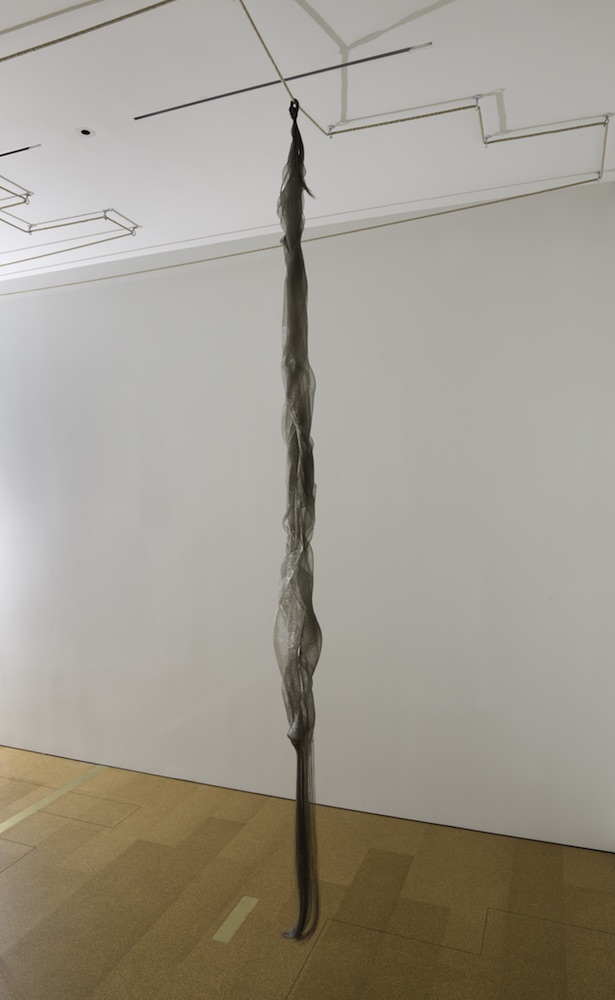
Leonor Antunes, a spiral staircase leads down to the garden, 2016; monofilament yarn, 159 × 8 × 8 in. (403.9 × 20.3 × 20.3 cm); Accessions Committee Fund purchase, 2016; © Leonor Antunes
Leonor Antunes exhumes the methods and materials of her artistic predecessors, combining them in ways that expose hidden currents in the history of art. For a spiral staircase leads down to the garden (2016), she undertook research on four female artists and designers and fused together elements of their work, revealing a genealogy of modern art at the intersection of weaving and sculpture.
The work’s title comes from a description of a building project by Greta Magnusson-Grossman (1906–1999), a Swedish designer and architect who moved to California during World War II. When first presented at SFMOMA—as part of a larger installation with the same title—a spiral staircase was suspended between arrangements of pressed cork on the floor and hanging rope on the ceiling that invoked the textile patterns of Anni Albers (1899–1994), a German émigré who arrived in the United States in 1933. The sculpture takes its most direct inspiration from Ruth Asawa (1926–2013) and Kay Sekimachi (b. 1926), Bay Area artists who developed a unique sculptural language in which strands of metal or nylon are woven into dense organic shapes and hung from the ceiling.
What at first may seem to be a jumble of citations soon reveals a subtle lineage. Between 1933 and 1949 Albers was an instructor at Black Mountain College in North Carolina, where she combined the idiom of abstraction and the practice of weaving. Asawa, who studied with Albers at the school, incorporated these lessons into woven wire sculptures. Sekimachi, who later encountered Asawa in the San Francisco Bay Area, developed a similar sculptural language but restored its association with fiber. The links between Albers, Asawa, and Sekimachi are by no means direct; rather, their complex, circuitous connection begins to resemble Magnusson-Grossman’s spiral staircase, whirling around a historical axis.
Weaving is a popular symbol of historical continuity: we often speak of the “warp and weft” of history and “threads” of transmission. The craft is also one of humanity’s oldest traditions, having emerged as early as the Paleolithic period thirty thousand years ago. At almost thirteen feet long, a spiral staircase allegorizes this ancestral descent, each thread twisting through hundreds of junctures, conjuring a vast lineal network. The sculpture’s resemblance to human hair taps into a similar resonance, evoking the passage of time in distinctly human terms. Antunes’s four protagonists are like strands in this web, each a filament in an intricate pattern of influence.
There is something else that connects Antunes’s predecessors: their slow assimilation into official canons of art and design. As female practitioners, Magnusson-Grossman, Albers, Asawa, and Sekimachi belong to what the artist once called “the history of forgetting”1—they are historically marginalized figures, although this has slowly changed. Antunes uses her sculpture to further remedy this neglect. She does not simply resurrect their work; she threads them together, foregrounds their connectivity, and creates a space for others to continue the critical work of remembering. Left unraveled at both ends, a spiral staircase remains open to further linkage. The sculpture’s title, too, spelled without a capital letter or a period, implies a before and an after. Antunes seems to suggest that this genealogy continues in both directions—further into the past and forward into the future.
Notes
- Helga Christoffersen, ed., Leonor Antunes: I Stand Like a Mirror Before You (New York: New Museum, 2015), 46.